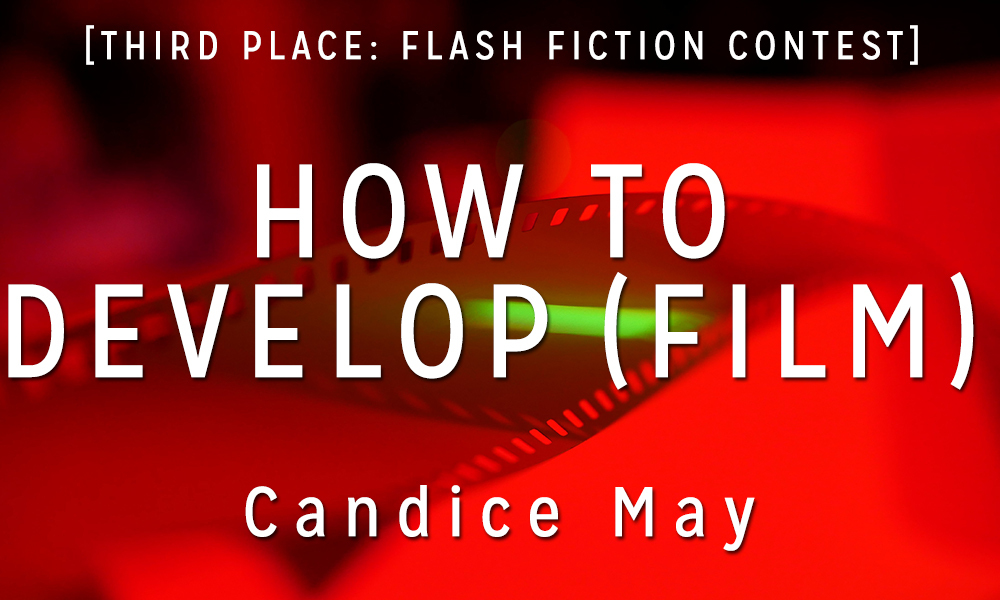Second person point of view, a how-to format, subtitles, fragmented narrative, open ending… There are a lot of modernist techniques at play in this story, but technique never overwhelms the underlying rawness of a young voice that is aware of the transgressive nature of her story. The point of view does what 2nd person usually does: disassociates the narrator from herself and her story. Her declarative sentence paced voice manages to be both appropriately flat and vividly fierce. The format of the how-to conceit, besides serving as a clever central metaphor, works when combined with the subtitles as an editing device that results in a sense of acceleration. You feel the light/dark flash of the scenes on your eyeballs. Closure—so often make/break in flash fiction–while unresolved, arrives with a lit fuse. — Guest Judge Stuart Dybek

- Materials and Set Up
You are a lonely girl in high school, and the darkroom is your favorite place to hang out, even at lunch time. While your so-called friends and classmates walk downtown for lunch, or smoke joints on the football field, you click the door closed and turn off all the lights. Except for the red light, the one that illuminates your flesh in a blood-hued tone as you gather the supplies: scissors, thermometer, plastic containers and toxic-smelling liquids. Stop bath, fixer, paper towels. And the film cassette, of course, with all your undeveloped pictures.
- Open Film Cassette
Exposing yourself to the light will ruin you, like the negatives, so you only do it here, in the darkroom, in the dark. For something so small, the cassette is heavy in your hands. You move around the room like an animal with night vision. When you’ve freed the film from its cassette, you consider the light switch on the wall. This is your moment to destroy the evidence, if you wanted to.
- Cut Film Off Cassette
It’s dark, so you’ll have to feel for the place to cut the film from the plastic. Your fingers unroll the film from its coil like you are undressing a teenager, like the way he undressed you, just days ago in this very room, sliding your knee socks down and then your underwear, double-checking the door was locked before pressing his face against you.
- Load Film onto Reel
Find slits and edges and slide it on. Twist, back and forth, wind up and wind down. You’ll know it’s ready when you’ve securely wrapped the film around the reel. When everything is secured and snug. Wrapped around. Loaded.
- Place Reel in Film Tank
When he joins you in the darkroom, you aren’t a lonely girl in high school. You pretend not to know his first name, only his last, and you call him Mister. He never says your name out loud, except during attendance and then, he doesn’t look at you. This is how the development process works. Make sure it’s tightly sealed and don’t open the lid. Don’t peek and don’t tell.
- Create Developer Mixture
This is your favorite part—the intense aroma. You mix developer liquid with water, inhaling the noxious fumes even though you know you shouldn’t. It smells poisonously sweet, like hurried sex, and you listen for a knock on the door as you stir the ingredients in a plastic tub.
- Measure Temperature of Mixture
All film is different, and developing time varies. So it goes with girls. You have long legs but a flat chest. Your hair is frizzy and last week, Alan—who is supposed to be your guy friend—said you probably have a gunt, which is a combination of gut and cunt. At home, you checked your naked body in the full-length mirror. You need more time.
- Pour Mixture into Film Tank
But you are not completely without agency. You make things happen, too. You left the door unlocked, you coyly tucked your hair behind your ear, you bit your lower lip and when he touched your cheek, you didn’t flinch away. You might have rested your fingers on his belt buckle. Even though you’re a shy girl, you’re also an artist and you can create the things you want.
- Agitate Film Periodically
During the development process, agitation is good. Spread the developer around, let it touch everything, especially the parts that think they have finished developing. Agitate, agitate. That’s why you brought your camera into math class and kept clicking even when Mister held up his hand and said, Enough, stop. That’s why you carry the zoom lens in your backpack, and you know which one is his bedroom window. You’ve memorized his phone number.
- Fill Tank with Stop Bath
You’re supposed to be able to say no. You could, if you wanted to. You could lock the door, you could make a phone call. You could change schools. You practice saying it out loud. No. Stop. Stop.
- Fill the Tank with Fixer
Lunch break is almost over and finally, a quiet rap on the door. Now his skin is red-hued, too, when he takes off his pants. He is urgent and sweaty. He makes you come, and holds his hand over your mouth so you won’t scream. Then he comes inside you, which is bad, it’s so bad, you know that, but all you can say is Yes. Don’t stop. For fifteen minutes, he fixes you, and you will never feel lonely again.
- Rinse and Soak Film
Stop taking my picture, he says. I see you doing it. Then he leaves, and you wash your face and hands with cold water. You pee into a plastic tub and watch his semen slide out of you, then pour it all down the sink. You’re almost done in here.
- Hang Film to Dry
Using clothespins, you clip your film to a hanging string. It’s so quiet.
- Clean and Store Film
You smooth down your hair and straighten your skirt. You cut the negatives into strips and slide them into a plastic sleeve for protection. You tuck them into your History textbook and head to class. At home, you’ll hold the negatives against your window and study the reversed images. You’ll see Mister’s darkened face, his hands trying to block the camera. You’ll see how exposed you’ve made him feel. You’ll keep the negatives in a shoebox under your bed, until you’re ready to make prints.
 Candice May is a writer from British Columbia, Canada. Her work has appeared or is forthcoming in Pleiades, december, The Porter House Review, Necessary Fiction, JMWW, under the gum tree, Sundog Lit, and elsewhere. She loves writing flash fiction and is currently working on a collection of short stories. Find her at: candicemay.ca
Candice May is a writer from British Columbia, Canada. Her work has appeared or is forthcoming in Pleiades, december, The Porter House Review, Necessary Fiction, JMWW, under the gum tree, Sundog Lit, and elsewhere. She loves writing flash fiction and is currently working on a collection of short stories. Find her at: candicemay.ca
